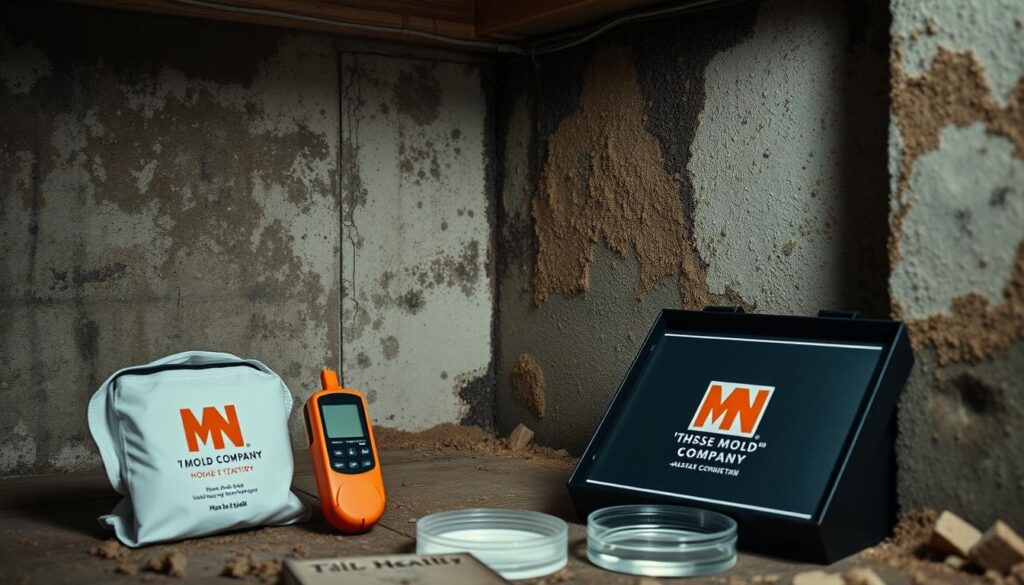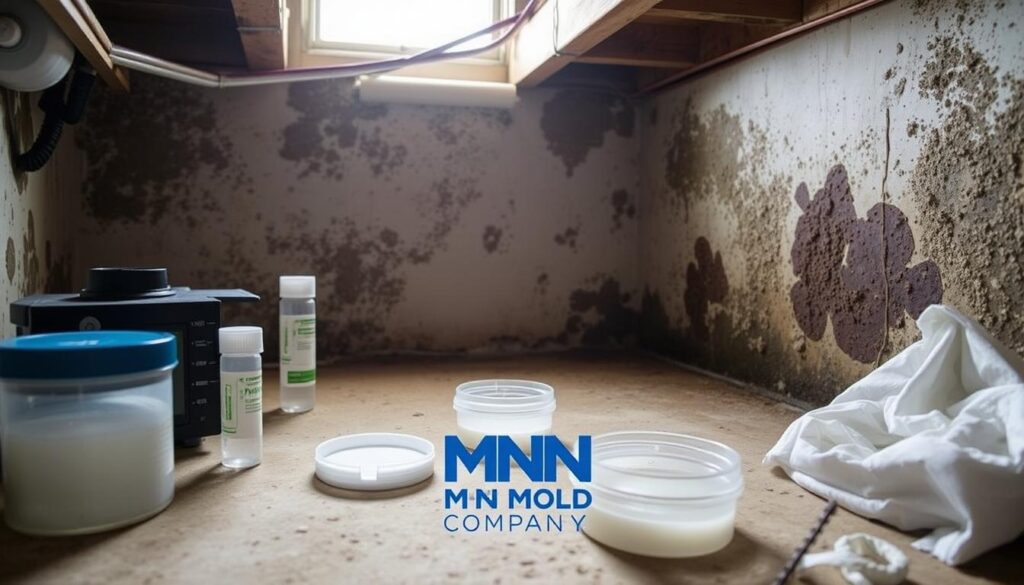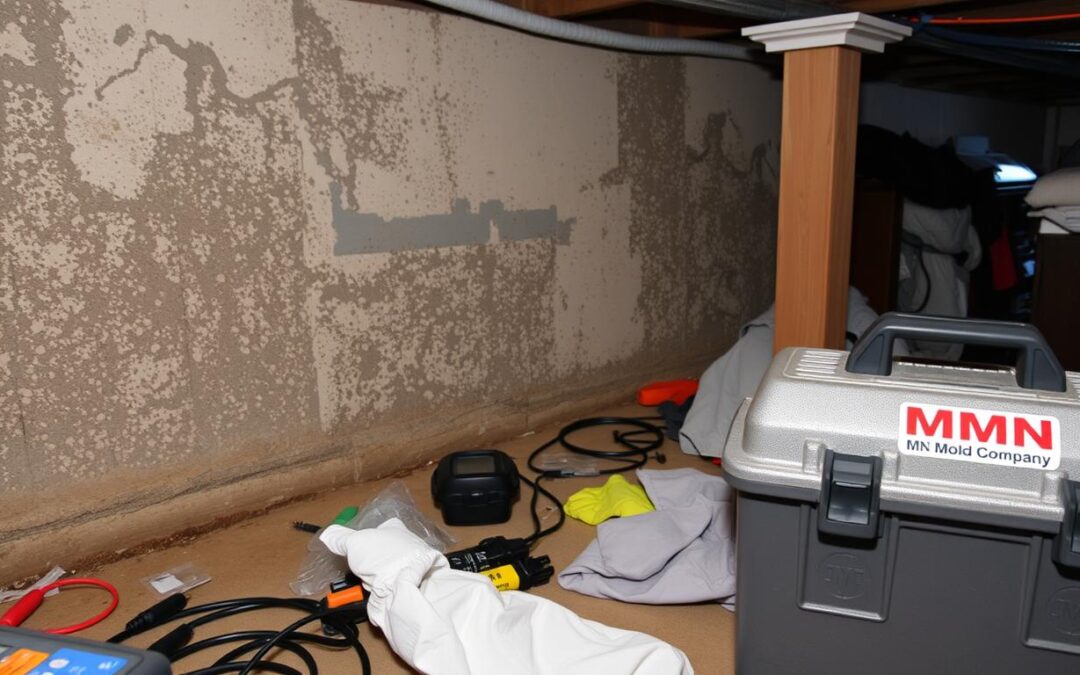Have you ever wondered about the unseen dangers in your home? Mold, a common problem, can be harmful if ignored. But how do you know if it’s in your home? The answer is professional mold testing, a key step to keep your home safe.
Mold is a big issue in many homes, causing health problems and damage. It can also lower your property’s value. That’s why it’s important to test for and fix mold problems quickly. A certified mold inspection is key for accurate detection and fixing.
An experienced inspector can spot mold growth and suggest how to prevent it. They use special techniques and talk clearly with clients. Knowing why mold testing is important helps you protect your home and family from mold’s dangers.
Key Takeaways
- Mold buildup in homes can lead to serious health problems and property damage if left untreated.
- Regular professional mold testing is crucial to identify and address mold issues early on.
- Certified inspectors use specialized techniques to accurately detect mold and provide effective remediation recommendations.
- Proper mold testing and remediation can safeguard your home’s health and value.
- Understanding the importance of mold testing empowers you to take proactive steps to protect your living space.
Understanding the Risks of Mold Growth
Mold is common in many homes and can be harmful if ignored. Knowing the signs of mold and its health risks is key to a safe home.
Visible Mold: Identifying the Signs
Mold is easy to spot because it’s visible. It can be black, green, brown, or white. It shows up as spots on moist surfaces like walls and floors. Catching these signs early can help prevent bigger problems.
Musty Odors: A Telltale Sign of Mold Presence
A musty smell is another sign of mold. This smell is strong and unpleasant. It means you might need to test your air for mold.
Health Complications: The Impact of Mold Exposure
Mold can harm your health, especially if you have allergies or breathing problems. Symptoms include sneezing, coughing, and itchy eyes. In serious cases, mold can make asthma worse or cause other breathing issues. If you think you have mold, get it checked to keep your family safe.
When to Consider Mold Testing
If you see signs you need a home mold test, like mold, a musty smell, or health issues, it’s time to think about mold testing for air quality improvement. Even without obvious signs, mold testing is key in some cases to protect your home and health.
After Water Damage
Mold grows fast after water damage, from floods to leaks. Testing is vital to find hidden mold and figure out how to fix it.
Before Buying a Home
Getting a mold check before buying a home is smart. It helps you make a good choice and avoid health and money problems later.
After Remediating Mold
If you’ve had mold problems before, test your home after fixing it. This ensures mold is gone and the air is clean.
Health Concerns
Health issues like breathing problems, allergies, or tiredness might be from mold. Testing can find the cause and help fix it.
It’s important to get a professional mold inspector for accurate results. Don’t wait to get mold testing for air quality improvement in these situations.
Types of Mold Testing
Identifying mold in your home is crucial. Certified mold testing inspectors near me can help. They offer two main types of mold testing: non-viable and viable sampling.
Non-viable sampling, or air sampling, checks for mold spores in the air. It doesn’t tell if the spores are alive or dead. This method might not find the exact mold type.
Viable sampling, however, grows the sample to find live and dead spores. But, it might miss dead spores that are hard to catch.
Choosing between these methods depends on what you need to know. A certified mold testing inspector can guide you. They help pick the best test for your situation.
“Proper mold testing is crucial for identifying the type and extent of mold growth, which is essential for effective remediation and prevention.”
Using a professional mold testing service ensures the right tests are done. This gives a full picture of the mold problem. Knowing this helps create a good plan to fix the issue and keep your family safe.
The Cost of Mold Testing
Knowing the cost of mold testing is key for homeowners and property managers. The price changes based on the test type and how much testing is needed. Professional services can cost between $300 to $600. Some tests might cost up to $1,000 or more.
Air Sampling Costs
Air sampling is the cheapest option, costing $150 to $300 per sample. It collects airborne particles to check for mold types and levels indoors.
Surface Sampling Costs
Surface sampling costs $50 to $150 per sample. It takes samples from affected surfaces to find mold species on walls, floors, or furniture.
Bulk Sampling Costs
Bulk sampling costs $50 to $250 per sample. It involves analyzing a physical piece of material for mold growth and its effect on building materials.
Culture and DNA testing are the priciest, costing $100 to $500 per sample. For those on a budget, DIY kits might seem cheaper. But, they’re not as reliable as professional tests.
| Mold Testing Method | Cost Range |
|---|---|
| Air Sampling | $150 – $300 per sample |
| Surface Sampling | $50 – $150 per sample |
| Bulk Sampling | $50 – $250 per sample |
| Culture and DNA Testing | $100 – $500 per sample |
For thorough mold testing, it’s best to hire experienced pros. They offer accurate and reliable results. Understanding mold testing costs helps homeowners and property managers make smart choices to tackle mold issues.

Choosing a Professional Mold Inspector
Ensuring your home’s safety and health means hiring a certified mold testing inspector. These experts can spot and identify mold growth accurately. They also know the type of mold you have. By choosing an independent and unbiased certified mold testing inspector near me, you get reliable results.
Look for mold inspection companies with certifications from groups like the American Council for Accredited Certification (ACAC). These show the inspector’s deep knowledge and experience. Professional mold testing services for homes by certified experts offer crucial insights into mold issues in your property.
| Certification | Accrediting Body | Expertise |
|---|---|---|
| Certified Mold Inspector (CMI) | ACAC | Comprehensive mold assessment and testing |
| Certified Microbial Consultant (CMC) | ACAC | Mold identification and remediation guidance |
| Certified Indoor Environmentalist (CIE) | ACAC | Indoor air quality and environmental assessments |
Choosing a certified mold inspection company means you get unbiased and accurate results. This helps you make smart choices about fixing mold problems in your home.
“Hiring a certified mold testing inspector is the best way to identify and address any mold problems in your home, ensuring the health and safety of your family.”
What to Expect During Mold Testing
Mold testing in homes can seem scary. But knowing what to expect can make it easier. Let’s explore the mold testing steps.
First, you’ll meet a qualified mold inspector. They’ll talk to you and learn about your home. Then, they’ll look for any mold signs or problem spots.
Based on what they find, they might take samples. These could be air, surface, or bulk samples. They’re sent to a lab for testing.
| Sample Type | Purpose |
|---|---|
| Air Samples | Measure airborne mold spore levels |
| Surface Samples | Identify the specific types of mold present on surfaces |
| Bulk Samples | Determine the composition and extent of mold growth within building materials |
After the lab gets the samples, they’ll tell you what they found. They’ll give you a detailed report. This report will say what mold is there and how much. It will also suggest how to fix it and prevent it in the future.
Knowing about mold testing helps you work with experts. It lets you make smart choices for your home’s health and safety.

Understanding Mold: Its Presence and Effects
Mold is a common fungus that grows in damp places. It spreads on many organic materials. While different molds have various colors, the color doesn’t always show how dangerous they are. Mold exists both inside and outside, in every climate and season, spreading through the air.
Testing for black mold in homes and mold spores in the air is key to understanding mold risks. Since mold spores are everywhere, it’s hard to avoid them. But, too much mold or certain types can be very harmful. So, it’s important to test for mold and fix it to keep homes healthy.
| Mold Type | Potential Health Effects |
|---|---|
| Aspergillus | Respiratory infections, allergic reactions, and potential toxin production |
| Penicillium | Allergic reactions, respiratory issues, and potential toxin production |
| Stachybotrys (Black Mold) | Severe respiratory problems, immune system damage, and potential neurological effects |
Testing for mold spores in the air and black mold in homes helps find and fix mold. This keeps homes safe and healthy. By knowing the risks and acting early, homeowners can protect their homes and families.
“Mold exposure can have serious health consequences, making proactive testing and remediation essential for maintaining a safe and healthy home environment.”
Toxic Mold and Environmental Testing
Toxic mold can be a big health risk indoors. But, it’s key to know that mold itself isn’t toxic. The real danger is from mycotoxins, like those from Stachybotrys chartarum, which should be treated like other molds.
There are no set rules for mold levels in homes. This makes black mold testing for residential properties or mold testing for air quality improvement tricky. Instead, look for musty smells and check for mold visually.
| Mold Type | Potential Health Effects | Testing Recommendations |
|---|---|---|
| Stachybotrys chartarum (black mold) | Respiratory issues, immune system damage, neurological problems | Visual inspection, air and surface sampling |
| Aspergillus | Allergic reactions, respiratory infections, lung damage | Visual inspection, air and surface sampling |
| Penicillium | Allergic reactions, respiratory problems, immune system suppression | Visual inspection, air and surface sampling |
It’s vital to tackle mold quickly to keep your home safe. Knowing how mold testing works helps you make better choices. This way, you can keep your air clean and your family healthy.
“The key to effective mold management is a comprehensive approach that combines visual inspections, targeted sampling, and prompt remediation efforts.”
Proper Mold Remediation Practices
Dealing with mold in your home needs the right approach. Mold testing services for homes and comprehensive mold testing solutions for homes help find the problem’s size. But fixing it right is key to a healthy home.
Good mold fixing involves several steps. First, dry wet materials in 48 hours to stop mold growth. Then, fix the moisture problem to keep it from coming back. Lastly, follow strict guidelines, like using barriers to stop mold spores from spreading.
Fixing mold wrong, like just painting over it, can make things worse. It can damage your home more and make health problems worse. To fix it right, use tools like the NIOSH Dampness and Mold Assessment Tool.
“Effective mold remediation is crucial for maintaining a healthy home environment and preventing long-term damage.”
By following these steps and getting help from professional mold testing services for homes and comprehensive mold testing solutions for homes, you can safely fix mold. This will make your home safe and sound again.
| Key Steps in Proper Mold Remediation |
|---|
|
Mold Testing: A Comprehensive Approach
Mold testing is key to keeping your home safe and healthy. It helps you understand the types of mold, the costs, and the need for a professional. This way, you can tackle mold problems effectively. It’s all about protecting your family and your home’s value.
Knowing the different mold tests is important. Mold testing for air quality improvement includes air, surface, and bulk sampling. Each has its own benefits and considerations. Choosing the right test for your situation ensures accurate results.
The cost of mold testing matters too. Prices vary for air, surface, and bulk sampling. Knowing these costs helps you budget. A professional mold inspector adds to the cost but ensures thorough testing and reliable results.
“Mold testing is not a one-size-fits-all solution. It’s a critical step in addressing mold issues and protecting the health of your home and family.”
A comprehensive mold testing approach helps you understand the problem. It guides you on what to do next and ensures effective remediation. This approach keeps your indoor environment healthy and prevents mold’s long-term effects.
- Understand the different types of mold testing available
- Consider the cost of each testing method
- Hire a professional mold inspector to ensure accurate and reliable results
- Implement proper remediation practices based on the test findings
- Continuously monitor for any signs of mold growth to prevent future issues
By taking a comprehensive approach to mold testing, you can protect your home, your family’s health, and your property’s value. Don’t wait until the problem becomes severe – take proactive steps to address mold concerns and ensure a healthy indoor environment.
Conclusion
Mold testing is key to keeping your home safe and healthy. It helps you spot mold risks and signs early. Working with mold experts ensures your family stays safe.
Seeing mold, smelling musty odors, or worrying about health? Mold testing can help. Affordable services from trusted providers make it easy to find and fix mold issues. This keeps your home clean and healthy.
Make mold testing a part of your home care routine. It improves your indoor air and protects your home’s value. Stay alert and work with experts to ensure a safe, comfy home for your family.
FAQ
What are the signs that indicate the need for mold testing in a home?
Signs you might need mold testing include seeing mold, smelling musty odors, or feeling sick. Sneezing, coughing, and breathing problems could be linked to mold.
When should I consider having my home tested for mold?
You might need mold testing after water damage, before buying a home, or after fixing mold issues. It’s also wise to test if you’re experiencing health problems that could be mold-related.
What are the different types of mold testing?
Mold testing comes in two types. Non-viable sampling finds mold spores. Viable sampling grows the sample to find live and dead spores.
How much does mold testing typically cost?
Mold testing prices vary. Professional tests can cost between $300 and $600. Some tests might cost up to $1,000. Air sampling is usually cheaper, while culture and DNA tests are pricier.
What should I look for when hiring a professional mold inspector?
Look for a mold inspector who is independent and unbiased. They should have certifications from groups like the American Council for Accredited Certification (ACAC). This ensures they give accurate results.
What can I expect during the mold testing process?
The mold testing process starts with a consultation and a visual check. Then, samples are collected and sent to a lab. After, the results are explained, and steps for fixing and preventing mold are suggested.
What is the difference between mold and toxic mold?
Some molds can make toxins, but they’re not toxic themselves. The danger from molds that make toxins is similar to other common molds.
How can I ensure proper mold remediation in my home?
To fix mold right, dry wet materials in 48 hours and fix any water leaks. Follow proper cleanup steps and use the NIOSH Dampness and Mold Assessment Tool to check your work.
,000. Air sampling is usually cheaper, while culture and DNA tests are pricier.

